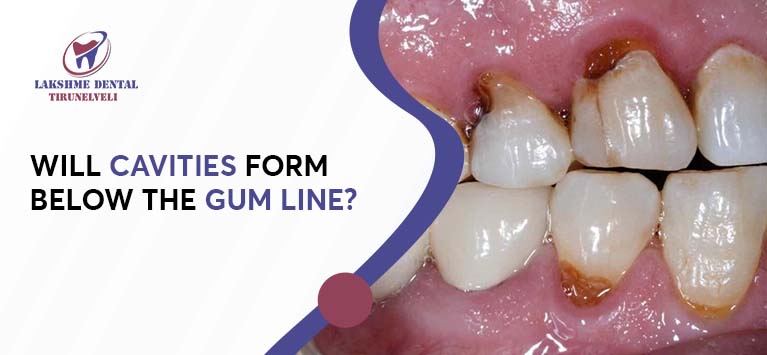
Will cavities form below the gum line?
Cavities can occur anywhere on a tooth. Gum line cavity refers to the dental cavity formed on the gingival sulcus (i.e.) the point where a tooth and gums meet.
Depending on the place a tooth developed cavity, it is classified into 3 types as – Smooth surface cavity, Biting surface cavity, and Root Cavities. Surprisingly, the gum line cavity falls under the category of both smooth surface cavity and root cavity.
It is because the cavity is developed in the region between teeth and gums. It implies that gum line cavities are more likely to occur on the smooth surface of a tooth’s crown part as well as on the root surfaces. The treatment options also vary for which part of the tooth is infected.
How do gum line cavities develop?
Similar to cavities in a tooth’s open surface, the gum line cavity also begins with the build-up of bacteria inside your mouth. The sugar substances in foods and drinks you consume feed the microbes and produce acids that can dissolve the hard minerals in a tooth, leading to cavities.
Following are the two primary contributing reasons for cavities along the gum line:
- Plaque build-up – Saliva mix with oral bacteria and forms a sticky substance called “Plaque” on the teeth around the gum margins. If it is not removed, it will harden and transform into tartar. In general, such plaque deposits accumulate in the space between the teeth and areas like pits and fissures of a back tooth. Similarly, plaque build-up also occurs along the gum line.
In such cases, the bacteria in tartar tend to irritate your gums as well as weaken the enamel and end in gum line cavities.
- Gum Recession – It is a condition in which the gum tissues around a tooth begin to pull away from the tooth. People who are encountering receding gums are more susceptible to having gumline cavities than others. It is because our tooth roots are enveloped with a layer of tissue called cementum and it is weaker than enamel. When gums recede, they expose the softer layers of a tooth and make them prone to bacterial invasion.
To put it simply, receding gums increase the risk of developing cavities in the space covered by gums.
Note: Factors like aging, poor oral hygiene, and certain medications that increase the dryness in your mouth also increase the risk of getting cavities below the gum line.
What are the symptoms of gum line cavity?
Having cavities near or beneath the gum line can be identified with the following signs:
- Pits and holes in the surface of a tooth
- Pain around and underneath the gum line but not in the tip of a tooth
- Bad breath
- Looseness in teeth
- Soreness in gums
- Gums appear puffy and inflamed
- Sharp pain in teeth while having hot, cold, sweet, and spicy foods or drinks
When compared to treating cavities in the open surfaces of teeth, treating cavities along the gum line is quite challenging. So you should visit your dentist immediately if you notice abnormalities in the gums.
How do dentists fix cavities at the gum line?
You have various clinical procedures to treat cavities below the gum line and dentists choose the best one based on the severity of the illness. In most circumstances, restorative procedures are performed.
- Fluoridated Toothpaste – If the gum line cavity is detected in the early stage, there will be a minimal infection. Even though there is not any enamel loss, demineralization might have occurred to a certain extent. In such cases, take toothpaste that has a high fluoride content to treat it.
- Gum line fillings – Composite fillings are required to treat gum line cavities if the infection is medium and is developed on a tooth’s smooth surface. It involves drilling the tooth’s infected portion under the gums and adding filling materials like composite resin material.
When the infection reaches beyond the gum line, rigorous treatments are necessary.
For instance, if a cavity along the gum line is developed due to gum recession, deep cleaning procedures below the gum line such as scaling and root planing will be performed. Aside from removing the debris, the procedure is followed by drilling and filling the cavity.
In case, if the infection inside a tooth reaches the root, a restorative dental procedure called Root Canal Treatment (RCT) is performed. It involves cleaning the infection inside the problematic tooth to prevent it from extraction.
Bottom line
Similar to cavities on the open surfaces of teeth, dental damage can occur easily underneath the gums. It is harmless in the primary stage of infection but triggers a lot of problems when it continues to evolve. Maintaining an effective oral hygiene regimen and getting periodontal checkups are the key to avoiding developing gum line cavities.
Want to know more oral care tips to prevent the development of cavities along the gum line? Contact our dentists in Tirunelveli here.










